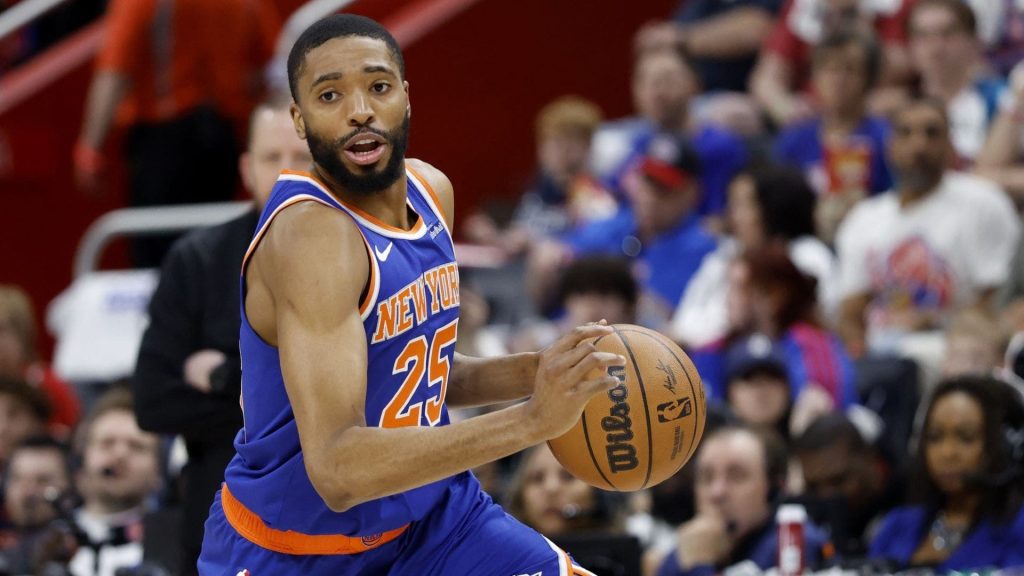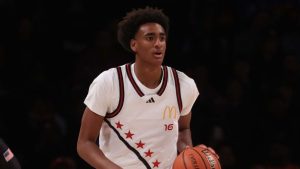With a 118-116 win on Thursday night, the Knicks took a 2-1 lead in their first round series against the Detroit Pistons. Much has happened in this series, including a 21-0 run, ravenous crowds, and three competitive games.
Let’s look at some trends that have played out in the first few contests…
One-two punch
After a quiet 10 points in Game 2, Karl-Anthony Towns rebounded with 31 points and eight boards in Thursday night’s Game 3 victory. Jalen Brunson continued to manufacture points, scoring at least 30 for a third consecutive contest.
Having two stars who draw so much attention on the offensive end is a luxury. But the Knicks have to find a balance to make sure both stars are featured in the offense. The first two games of the series saw Brunson attempt 27 shots each night. In Game 3, he had 20 field goal attempts.
When Brunson and Towns are on the floor together, the Knicks have been at their best. In 95 minutes together, the duo is outscoring the Pistons by 7.8 points per 100 possessions, according to PBP Stats. Both players draw so much attention and their defenders have refused to help off them, opening up one-on-one opportunities for the Knicks’ role players.
If both stars are involved in the offense, the Knicks should continue to thrive.
A net negative
Game 3 saw Mikal Bridges have his best individual performance with 20 points, seven rebounds, three assists, and three steals in 39 minutes. Though Bridges’ raw numbers in the series (15.7 points and 4.7 rebounds) look good enough, the on-off data is troubling. In 106 minutes with Bridges on the floor, the Knicks are a negative 8.9 points per 100 possessions.
It’s a small sample size of only three games, but it does reinforce that Bridges has been inconsistent in the postseason. Before the series, I wrote that Bridges would be New York’s X-factor for the first round. He hasn’t been the two-way role player that the Knicks had hoped for.
And it’s made the series a bit more challenging as New York heavily relies on Bridges. Even though Cameron Payne was a catalyst in the Knicks’ Game 1 comeback, New York’s bench has averaged just 13.0 points in the playoffs, so there aren’t many options the Knicks can go to if Bridges struggles.
Plus-minus isn’t everything when evaluating players. Bridges had a strong performance in Game 3 and was a minus-four. But it should be a number to watch for as the playoffs progress.
Possession game
Over the past few years, the Knicks have relied on rebounding to secure wins. Specifically, offensive rebounding was a central reason for the club getting out of the first round the last two years.
This season, the Knicks are not a dominant rebounding team, but they are solid. During the regular season, the Knicks were 12th in defensive rebound rate and ninth in offensive rebound percentage.
The Pistons have exposed some weaknesses for the Knicks on the glass. In the first three games, Detroit has 34 offensive rebounds while the Knicks have 24. Pistons center Jalen Duren has caused havoc on the offensive glass, collecting 12 offensive rebounds in the series. Despite the Knicks losing the edge on the offensive glass, they have been able to make up for it in other areas. The Pistons have committed 15 more turnovers than the Knicks.
We’ll see if any of these trends continue.
With a 118-116 win on Thursday night, the Knicks took a 2-1 lead in their first round series against the Detroit Pistons. Much has happened in this series, including a 21-0 run, ravenous crowds, and three competitive games.
Let’s look at some trends that have played out in the first few contests…
One-two punch
After a quiet 10 points in Game 2, Karl-Anthony Towns rebounded with 31 points and eight boards in Thursday night’s Game 3 victory. Jalen Brunson continued to manufacture points, scoring at least 30 for a third consecutive contest.
Having two stars who draw so much attention on the offensive end is a luxury. But the Knicks have to find a balance to make sure both stars are featured in the offense. The first two games of the series saw Brunson attempt 27 shots each night. In Game 3, he had 20 field goal attempts.
When Brunson and Towns are on the floor together, the Knicks have been at their best. In 95 minutes together, the duo is outscoring the Pistons by 7.8 points per 100 possessions, according to PBP Stats. Both players draw so much attention and their defenders have refused to help off them, opening up one-on-one opportunities for the Knicks’ role players.
If both stars are involved in the offense, the Knicks should continue to thrive.
A net negative
Game 3 saw Mikal Bridges have his best individual performance with 20 points, seven rebounds, three assists, and three steals in 39 minutes. Though Bridges’ raw numbers in the series (15.7 points and 4.7 rebounds) look good enough, the on-off data is troubling. In 106 minutes with Bridges on the floor, the Knicks are a negative 8.9 points per 100 possessions.
It’s a small sample size of only three games, but it does reinforce that Bridges has been inconsistent in the postseason. Before the series, I wrote that Bridges would be New York’s X-factor for the first round. He hasn’t been the two-way role player that the Knicks had hoped for.
And it’s made the series a bit more challenging as New York heavily relies on Bridges. Even though Cameron Payne was a catalyst in the Knicks’ Game 1 comeback, New York’s bench has averaged just 13.0 points in the playoffs, so there aren’t many options the Knicks can go to if Bridges struggles.
Plus-minus isn’t everything when evaluating players. Bridges had a strong performance in Game 3 and was a minus-four. But it should be a number to watch for as the playoffs progress.
Possession game
Over the past few years, the Knicks have relied on rebounding to secure wins. Specifically, offensive rebounding was a central reason for the club getting out of the first round the last two years.
This season, the Knicks are not a dominant rebounding team, but they are solid. During the regular season, the Knicks were 12th in defensive rebound rate and ninth in offensive rebound percentage.
The Pistons have exposed some weaknesses for the Knicks on the glass. In the first three games, Detroit has 34 offensive rebounds while the Knicks have 24. Pistons center Jalen Duren has caused havoc on the offensive glass, collecting 12 offensive rebounds in the series. Despite the Knicks losing the edge on the offensive glass, they have been able to make up for it in other areas. The Pistons have committed 15 more turnovers than the Knicks.
We’ll see if any of these trends continue.













